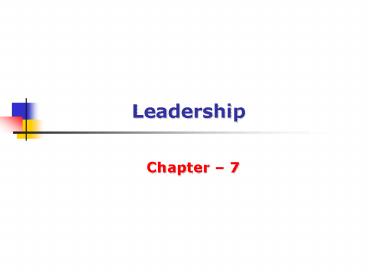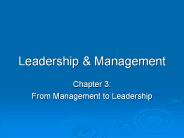Leadership - PowerPoint PPT Presentation
1 / 41
Title:
Leadership
Description:
Laissez-faire (free-rein) Chapter 7 Leadership. 9. X & Y Theories ... (S-L) Laissez-Faire. Low directive/low supportive. Provide little or no direction and support. ... – PowerPoint PPT presentation
Number of Views:54
Avg rating:3.0/5.0
Title: Leadership
1
Leadership
- Chapter 7
2
Learning Objectives
- Explain what leadership is and how it affect
behavior. - Describe leadership trait theory.
- List and describe five behavioral leadership
theories. - List and describe four contingency leadership
theories. - Explain four situational supervisory styles.
- Identify three characteristics that substitute
for leadership.
3
Leadership vs. Management
- Leadership is a process of influencing individual
and group activities toward goal setting and goal
achievement. - Management the process of working with and
through people to achieve objectives by means of
effective decision making and coordination of
available resources
4
Leadership vs. ManagementFunctions
- Management
- Planning
- Organizing
- Staffing
- Leading
- Controlling
- Leadership
- Valuing
- Visioning
- Coaching
- Empowering
- Team building
- Promoting quality
- Listening and Empathy
5
Leadership Traits
- Leadership trait theory assumes that
- there are distinctive physical and psychological
characteristics accounting for leadership
effectiveness.
6
LGhisellis Six Significant Leadership Traits
- Supervisory ability (Getting the job done through
others). - Need for occupational achievement (Seeking
responsibility). - Intelligence (Good judgment, reasoning, thinking
capacity). - Decisiveness (Solve problems and make decision).
- Self-assurance (Copes with problems,
self-confidence). - Initiative (Self-starting).
7
Behavioral Leadership Theories
- Behavioral leadership theories assume that there
are distinctive styles that effective leaders use
consistently, or, that good leadership is rooted
in behavior. - Basic Leadership Styles
- Two-Dimensional Leadership Styles
- Managerial Grid
- Transformational Leadership
8
Basic Leadership Style
- Autocratic (Theory X)
- Democratic (Theory Y)
- Laissez-faire (free-rein)
9
X Y ltTheoriesgt
- Theory X employees dislike work and must be
closely supervised to get them to do their work. - Supervisors who accept Theory X assumptions will
be more inclined to prefer a structured,
autocratic leadership style.
10
X Y ltTheoriesgt
- Theory Y employees like to work and need not be
closely supervised to get them to do - their work.
- Supervisors who accept Theory Y assumptions will
be more inclined to prefer a supportive,
participative leadership style.
11
Factors AffectingLeadership Style
- The Theory X or Theory Y management philosophy is
basically determined by a managers assumptions
about the nature of people. - The followers readiness level
- The situation faced by the supervisor, including
the nature of the work and types of assignments,
will have a major influence on his or her
leadership style.
12
The Followers Readiness Level
- Readiness level is the state of a persons drive
and need for achievement it results from the
followers experience, education, attitudes, and
willingness and ability to accept responsibility. - The readiness concept can be expressed in the
formula - Readiness Ability Willingness
- If followers are less ready, the leader should
use a different style than with followers at a
high readiness level.
13
Two-Dimensional Leadership Style ltOhio State/U
of Michigan Modelgt
14
The Leadership Grid
15
The Leadership Grid
- The Leadership Grid, originally published as the
Managerial Grid by Blake and Mouton, shows that
leadership style has two concerns production and
people. - Authority compliance, or task management would be
used by a 9,1 leader (high concern for
production, low concern for people), who
structures the work, delegates as little as
possible, and is usually an autocrat. - Country club management would be used by a 1,9
leader (low concern for production, high concern
for people), who is supportive and somewhat
permissive, emphasizing the need to keep
employees happy and satisfied.
16
The Leadership Grid
- The 5,5 leader uses a middle of the road
management style, placing some emphasis on
production and some emphasis on people. - The 1,1 leader reflects impoverished management,
in which the supervisor has completely abdicated
the leadership role. - The 9,9 leader uses team management he or she
believes in directing work through mutual
understanding and has a high concern for both
people and production. - Blake and associates believe that the 9,9 style
is the way to manage in leadership situations.
17
Transformational Leadership
- Transformational leadership is a paradigm shift
to a more visionary and empowering leadership
style, particularly needed in a world of rapid
and turbulent change - Transactional leadership is a more traditional
leadership approach and is similar to an exchange
process.
18
Transformational Leadership
- Transformational leadership focuses on the
behaviors of successful top-level managers. - Three acts
- Recognizing the need for revitalization.
- Creating a new vision.
- Instituting a change.
- Transformational leadership styles
- Charismatic Leadership
- Transactional Leadership
19
Charismatic Leadership
- Inspire loyalty
- Enthusiasm
- High level of performance
- But, they dont take the organization through the
three acts!!!
20
Transactional Leadership
- Identifies desired performance standards.
- Recognize what types of rewards employees want
from their work. - Takes actions that make receiving these rewards
contingent upon achieving performance standards. - Operates within the existing culture and uses
traditional management strategies.
21
Transformational LeadershipCharacteristics or
Traits
- See themselves as change agents
- Take risks
- Believe in people and motivate them
- Value driven
- Life-long learners
- Ability to deal with complexity, ambiguity and
uncertainty - Visionaries
22
Contingency Leadership Theories
- Contingency Leadership Theory
- Leadership Continuum
- Normative Leadership Theory
- Situational Leadership
23
Contingency Leadership Theory
- Contingency leadership theory Fiedlers model to
determine if leadership style is task or
relationship orients, and if the situation
matches the style. - Leadership style
- Determined by filling out LPC scales.
- Situational Favorableness
- Leader-member relations.
- Task structure.
- Position power.
24
Determining The Appropriate Leadership StyleTask
vs. Relationship
Start
25
Leadership Continuum
- The continuum of leadership behaviors is useful
when a supervisor is considering the degree to
which employees should be involved in decision
making. - The continuum of power has two parts use of
authority by the supervisor, and area of freedom
for employees. - The greater the authority the supervisor uses,
the smaller the area of freedom for employees.
26
Leadership ContinuumltFactors to be consideredgt
- The Manager
- The Subordinates
- The Situations
- Preferred style, based on experience,
expectation, values, background, knowledge,
confidence in the subordinates - Environmental considerations org. size,
structure, goals, technology
27
Continuum of Leadership Behavior
Autocratic style
Participative style
28
Normative Leadership Theory (I)
- Normative leadership theory Vroom and Yettons
decision-tree model that enables user to select
on of five leadership style appropriate for the
situation.
29
Normative Leadership Theory ltFive Stylesgt
- AI Autocratic Leader makes decision alone with
available information. - AII Autocratic Leader makes decision alone,
but uses information from subordinates. - CI Consultative Leader meets with subordinates
individually, explains situation, gets
information and ideas. Leader may or may not use
subordinates input. Leader makes decision alone.
30
Normative Leadership Theory ltFive Stylesgt
- CII Consultative Leader meets with
subordinates as a group, with same process - as CI.
- GII Group oriented Leader meets with
subordinates as a group, explains the situation
and allows the group to make the decision.
31
Normative Leadership TheoryltThe Appropriate
Leadership Stylegt
- Is there a quality requirement such the one
solution is likely to be more rational than
another? - Do I have sufficient information to make a
high-quality decision? - Is the problem structured?
- Is acceptance of a decision by subordinates
critical to effective implementation?
32
Normative Leadership TheoryltThe Appropriate
Leadership Stylegt
- If I were to make the decision by myself, is it
reasonably certain that it would be accepted by
my subordinates? - Do subordinates share the organizational goals to
be attained in solving the problem? - Is conflict among subordinates likely in the
preferred solution (not relevant to individual
problems)? - Do subordinates have sufficient information to
make a high-quality decision?
33
Situational Leadership
- Situational Leadership is Hersey and Blanchards
model for selecting one of four leadership styles
that matches the employees maturity level in a
given situation. - Based on the life-cycle theory of leadership
holds that many leadership behaviors fall into
either one of two areas task behaviors or
relationship behaviors.
34
Situational LeadershipltLife-cycle Theorygt
- Task behaviors involve clarifying the job
telling people what to do, how to do it, and when
to do it providing follow-up and taking
corrective action. - Relationship behaviors involve providing people
with support, giving them positive feedback, and
asking for their opinions and ideas.
35
Situational LeadershipltFour Stylesgt
36
Situational Leadership Model
Capability Levels (C)
Supervisory Styles (S)
- C-1 Low
- The employees are unable and/or unwilling to do
the task without direction
- (S-A) Autocratic
- High directive/low supportive
- Tell employee what to do and closely oversee
performance - Give little or no support
- Make decisions by yourself
37
Situational Leadership Model
Capability Levels (C)
Supervisory Styles (S)
- C-2 Moderate
- The employees have moderate ability and are
motivated
- (S-C) Consultative
- High directive/high supportive
- Sell employees on doing the job your way and
macro-management. - You may include their input in your decisions
38
Situational Leadership Model
Capability Levels (C)
Supervisory Styles (S)
- C-3 High
- the employees are high in ability but may lack
self-confidence or motivation
- (S-P) Participative
- Low directive/high supportive
- Provide little or general direction. Let
employees do the task their way.
Macro-management. Focus on end results, make
decisions together, but you have t final say
39
Situational Leadership Model
Capability Levels (C)
Supervisory Styles (S)
- C-4 Outstanding
- The employees are very capable and highly
motivated
- (S-L) Laissez-Faire
- Low directive/low supportive
- Provide little or no direction and support. Let
employees make their own decisions
40
Is One Leadership Style Best?
- Research shows that there is no one best style
for all situations. - However, in most situations, the appropriate
style is either coaching and selling or
participating and supporting. - The long-run trend in U.S. industry is for
supervisory managers to use more participative
styles.
41
Leadership
- Chapter 7
- Questions, Comments???































